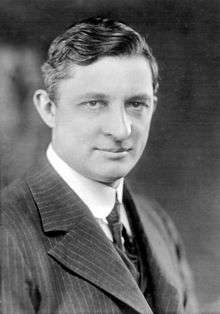Air conditioning
Air conditioning (often referred to as AC, A/C, or air con)[1] is the process of removing heat and moisture from the interior of an occupied space to improve the comfort of occupants. Air conditioning can be used in both domestic and commercial environments. This process is most commonly used to achieve a more comfortable interior environment, typically for humans and other animals; however, air conditioning is also used to cool and dehumidify rooms filled with heat-producing electronic devices, such as computer servers, power amplifiers, and to display and store some delicate products, such as artwork.
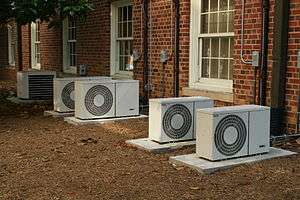
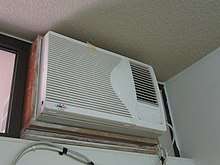
Air conditioners often use a fan to distribute the conditioned air to an enclosed space such as a building or a car to improve thermal comfort and indoor air quality. Electric refrigerant-based AC units range from small units that can cool a small bedroom, which can be carried by a single adult, to massive units installed on the roof of office towers that can cool an entire building. The cooling is typically achieved through a refrigeration cycle, but sometimes evaporation or free cooling is used. Air conditioning systems can also be made based on desiccants (chemicals which remove moisture from the air). Some AC systems reject or store heat in subterranean pipes.[2]
In construction, a complete system of heating, ventilation, and air conditioning is referred to as HVAC.[3] As of 2018, 1.5 billion air conditioning units were installed, with the International Energy Agency expecting 5.6 billion units in use by 2050.[4] Globally, current air conditioning accounts for 1/5 of energy usage in buildings globally, and the expected growth of the usage of air conditioning, will drive significant energy demand growth.[4] In response to, in 2018 the United Nations called for the technology to be made more sustainable to mitigate climate change.[5][6]
History
Evaporative cooling
Since prehistoric times, snow and ice were used for cooling. The business of harvesting ice during winter and storing for use in summer became popular towards the late 17th century.[7] This practice was replaced by mechanical ice-making machines.
The basic concept behind air conditioning is said to have been applied in ancient Egypt, where reeds were hung in windows and were moistened with trickling water. The evaporation of water cooled the air blowing through the window. This process also made the air more humid, which can be beneficial in a dry desert climate. Other techniques in medieval Persia involved the use of cisterns and wind towers to cool buildings during the hot season.[8]
The 2nd-century Chinese mechanical engineer and inventor Ding Huan of the Han Dynasty invented a rotary fan for air conditioning, with seven wheels 3 m (10 ft) in diameter and manually powered by prisoners.[9] In 747, Emperor Xuanzong (r. 712–762) of the Tang Dynasty (618–907) had the Cool Hall (Liang Dian 涼殿) built in the imperial palace, which the Tang Yulin describes as having water-powered fan wheels for air conditioning as well as rising jet streams of water from fountains. During the subsequent Song Dynasty (960–1279), written sources mentioned the air conditioning rotary fan as even more widely used.[10]
In the 17th century, the Dutch inventor Cornelis Drebbel demonstrated "Turning Summer into Winter" as an early form of modern air conditioning for James I of England by adding salt to water.[11]
Development of mechanical cooling
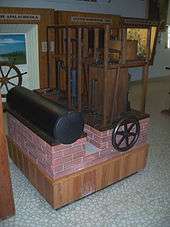
In 1758, Benjamin Franklin and John Hadley, a chemistry professor at Cambridge University, conducted an experiment to explore the principle of evaporation as a means to rapidly cool an object. Franklin and Hadley confirmed that evaporation of highly volatile liquids (such as alcohol and ether) could be used to drive down the temperature of an object past the freezing point of water. They conducted their experiment with the bulb of a mercury thermometer as their object and with a bellows used to speed up the evaporation. They lowered the temperature of the thermometer bulb down to −14 °C (7 °F) while the ambient temperature was 18 °C (64 °F). Franklin noted that, soon after they passed the freezing point of water 0 °C (32 °F), a thin film of ice formed on the surface of the thermometer's bulb and that the ice mass was about 6 mm (1⁄4 in) thick when they stopped the experiment upon reaching −14 °C (7 °F). Franklin concluded: "From this experiment one may see the possibility of freezing a man to death on a warm summer's day."[12]
In 1820, English scientist and inventor Michael Faraday discovered that compressing and liquefying ammonia could chill air when the liquefied ammonia was allowed to evaporate. In 1842, Florida physician John Gorrie used compressor technology to create ice, which he used to cool air for his patients in his hospital in Apalachicola, Florida. He hoped to eventually use his ice-making machine to regulate the temperature of buildings. He even envisioned centralized air conditioning that could cool entire cities. Though his prototype leaked and performed irregularly, Gorrie was granted a patent in 1851 for his ice-making machine. Though his process improved the artificial production of ice, his hopes for its success vanished soon afterwards when his chief financial backer died and Gorrie did not get the money he needed to develop the machine. According to his biographer, Vivian M. Sherlock, he blamed the "Ice King", Frederic Tudor, for his failure, suspecting that Tudor had launched a smear campaign against his invention. Dr. Gorrie died impoverished in 1855, and the dream of commonplace air conditioning went away for 50 years.
James Harrison's first mechanical ice-making machine began operation in 1851 on the banks of the Barwon River at Rocky Point in Geelong, Australia. His first commercial ice-making machine followed in 1853, and his patent for an ether vapor compression refrigeration system was granted in 1855. This novel system used a compressor to force the refrigeration gas to pass through a condenser, where it cooled down and liquefied. The liquefied gas then circulated through the refrigeration coils and vaporized again, cooling down the surrounding system. The machine produced 3,000 kilograms (6,600 lb) of ice per day.
Though Harrison had commercial success establishing a second ice company back in Sydney in 1860, he later entered the debate over how to compete against the American advantage of ice-refrigerated beef sales to the United Kingdom. He wrote: "Fresh meat frozen and packed as if for a voyage, so that the refrigerating process may be continued for any required period", and in 1873 prepared the sailing ship Norfolk for an experimental beef shipment to the United Kingdom. His choice of a cold room system instead of installing a refrigeration system upon the ship itself proved disastrous when the ice was consumed faster than expected.
Electrical air conditioning
The creation of the modern electrical air conditioning unit and industry is credited to the American inventor Willis H. Carrier.[13][14][15][16] After graduating from Cornell University, Carrier found a job at the Buffalo Forge Company. There, he began experimenting with air conditioning as a way to solve an application problem for the Sackett-Wilhelms Lithographing and Publishing Company in Brooklyn, New York. The first air conditioner, designed and built in Buffalo, New York by Carrier, began working on 17 July 1902.[17]
Designed to improve manufacturing process control in a printing plant, Carrier's invention controlled not only temperature but also humidity. Carrier used his knowledge of the heating of objects with steam and reversed the process. Instead of sending air through hot coils, he sent it through cold coils (filled with cold water). The air was cooled, and thereby the amount of moisture in the air could be controlled, which in turn made the humidity in the room controllable. The controlled temperature and humidity helped maintain consistent paper dimensions and ink alignment. Later, Carrier's technology was applied to increase productivity in the workplace, and The Carrier Air Conditioning Company of America was formed to meet rising demand. Over time, air conditioning came to be used to improve comfort in homes and automobiles as well.
In 1906, Stuart W. Cramer of Charlotte was exploring ways to add moisture to the air in his textile mill. Cramer coined the term "air conditioning", using it in a patent claim he filed that year as an analogue to "water conditioning", then a well-known process for making textiles easier to process. He combined moisture with ventilation to "condition" and change the air in the factories, controlling the humidity so necessary in textile plants. Willis Carrier adopted the term and incorporated it into the name of his company.[18]
Shortly thereafter, the first private home to have air conditioning was built in Minneapolis in 1914, owned by Charles Gates.[19] Realizing that air conditioning would one day be a standard feature of private homes, particularly in regions with warmer climate, David St. Pierre DuBose (1898-1994) designed a network of ductwork and vents for his home Meadowmont, all disguised behind intricate and attractive Georgian-style open moldings. This building is believed to be one of the first private homes in the United States equipped for central air conditioning.[20]
In 1945, Robert Sherman of Lynn, Massachusetts invented a portable, in-window air conditioner that cooled, heated, humidified, dehumidified, and filtered the air.[21]
By the late 1960s, most newly built residential homes in the United States had central air conditioning. Box air conditioning units during this time also became more inexpensive which resulted in greater population growth in the states of Florida and Arizona. As of 2015, nearly 100 million homes or about 87% of US households had air conditioning systems.[22]
Refrigerant development
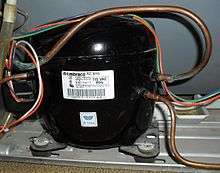
The first air conditioners and refrigerators employed toxic or flammable gases, such as ammonia, methyl chloride, or propane, that could result in fatal accidents when they leaked. Thomas Midgley, Jr. created the first non-flammable, non-toxic chlorofluorocarbon gas, Freon (R-12), in 1928. The name is a trademark name owned by DuPont for any chlorofluorocarbon (CFC), hydrochlorofluorocarbon (HCFC), or hydrofluorocarbon (HFC) refrigerant. The refrigerant names include a number indicating the molecular composition (e.g., R-11, R-12, R-22, R-134A). The blend most used in direct-expansion home and building comfort cooling is an HCFC known as chlorodifluoromethane (R-22).
Dichlorodifluoromethane (R-12) was the most common blend used in automobiles in the U.S. until 1994, when most designs changed to R-134A due to the ozone-depleting potential of R-12. R-11 and R-12 are no longer manufactured in the U.S. for this type of application, but is still imported and can be purchased and used by certified HVAC technicians. For systems requiring only an occasional "shot" of R-12 and otherwise in good working order and performing far better than virtually all "R-134a" systems whether "converted" or "factory", even $50-$100 per pound of R-12 is considered "cheap" by many individuals.
Modern refrigerants have been developed to be more environmentally safe than many of the early chlorofluorocarbon-based refrigerants used in the early- and mid-twentieth century. These include HCFCs (R-22, as used in most U.S. homes before 2011) and HFCs (R-134a, historically used in most cars, refrigerators and chillers) have replaced most CFC use. HCFCs, in turn, are supposed to have been in the process of being phased out under the Montreal Protocol and replaced by HFCs such as R-410A, which lack chlorine.[23] HFCs, however, contribute to climate change problems. Moreover, policy and political influence by corporate executives resisted change.[24][25] Corporations insisted that no alternatives to HFCs existed. The environmental organization Greenpeace provided funding to a former East German refrigerator company to research an alternative ozone- and climate-safe refrigerant in 1992. The company developed a hydrocarbon mix of isopentane and isobutane, but as a condition of the contract with Greenpeace could not patent the technology, which led to its widespread adoption by other firms.[26][27][28] Their activist marketing first in Germany led to companies like Whirlpool, Bosch, and later LG and others to incorporate the technology throughout Europe, then Asia, although the corporate executives resisted in Latin America, so that it arrived in Argentina produced by a domestic firm in 2003, and then finally with giant Bosch's production in Brazil by 2004.[29][30]
In 1995, Germany made CFC refrigerators illegal.[31] DuPont and other companies blocked the refrigerant in the U.S. with the U.S. EPA, disparaging the approach as "that German technology".[30][32] Nevertheless, in 2004, Greenpeace worked with multinational corporations like Coca-Cola and Unilever, and later Pepsico and others, to create a corporate coalition called Refrigerants Naturally!.[31][33] Then, four years later, Ben & Jerry's of Unilever and General Electric began to take steps to support production and use in the U.S.[34] In 2011 the EPA decided in favor of the ozone- and climate-safe refrigerant for U.S. manufacture.[26][35][36] HFCs like R-404a, R-134a and R-410a are, as of 2020, being replaced with HFO and hydrocarbon refrigerants like R-1234ze in chillers for commercial refigeration and air conditioning, R-1234yf in cars, R-32 in residential air conditioning and CO2 (R-744) in commercial refrigeration. R-600 (isobutane) is already widely used in residential refrigeration.
Operating principles
Refrigeration cycle

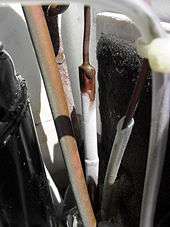
Cooling in traditional AC systems is accomplished using the vapor-compression cycle, which uses the forced circulation and phase change of a refrigerant between gas and liquid to transfer heat.
The vapor-compression cycle can occur within a unitary, or packaged piece of equipment; or within a chiller that is connected to terminal cooling equipment (such as a variable refrigerant flow terminal or fan coil unit) on its evaporator side and heat rejection equipment on its condenser side.
Heat pump
Some air conditioning systems have the option to reverse the refrigeration cycle and act as heat pumps, therefore producing heating instead of cooling in the indoor environment. They are also commonly referred to as "reverse cycle air conditioner". The heat pump is significantly more energy efficient than electric resistance heating, because it moves energy from air or groundwater to the heated space, as well as the heat from purchased electrical energy. When the heat pump is in heating mode, the indoor evaporator coil switches roles and becomes the condenser coil, producing heat. The outdoor condenser unit also switches roles to serve as the evaporator, and discharges cold air (colder than the ambient outdoor air).
Air-source heat pumps are more popular in milder winter climates where the temperature is frequently in the range of 4–13 °C (40–55 °F), because heat pumps become inefficient in more extreme cold. This is because ice forms on the outdoor unit's heat exchanger coil, which blocks air flow over the coil. To compensate for this, the heat pump system must temporarily switch back into the regular air conditioning mode to switch the outdoor evaporator coil back to being the condenser coil, so that it can heat up and defrost. Some heat pump systems will therefore have a form of electric resistance heating in the indoor air path that is activated only in this mode in order to compensate for the temporary indoor air cooling, which would otherwise be uncomfortable in the winter.
The icing problem becomes much more severe with lower outdoor temperatures, so heat pumps are commonly installed in tandem with a more conventional form of heating, such as an electrical heater, a natural gas, oil or tree fireplace or central heating, which is used instead of the heat pump during harsher winter temperatures. In this case, the heat pump is used efficiently during the milder temperatures, and the system is switched to the conventional heat source when the outdoor temperature is lower.
Evaporative cooling
In very dry climates, evaporative coolers, sometimes referred to as swamp coolers or desert coolers, are popular for improving coolness during hot weather. An evaporation cooler is a device that draws outside air through a wet pad, such as a large sponge soaked with water. The sensible heat of the incoming air, as measured by a dry bulb thermometer, is reduced. The temperature of the incoming air is reduced, but it is also more humid, so the total heat (sensible heat plus latent heat) is unchanged. Some of the sensible heat of the entering air is converted to latent heat by the evaporation of water in the wet cooler pads. If the entering air is dry enough, the results can be quite substantial.
Evaporative coolers tend to feel as if they are not working during times of high humidity, when there is not much dry air with which the coolers can work to make the air as cool as possible for dwelling occupants. Unlike other types of air conditioners, evaporative coolers rely on the outside air to be channeled through cooler pads that cool the air before it reaches the inside of a house through its air duct system; this cooled outside air must be allowed to push the warmer air within the house out through an exhaust opening such as an open door or window.[37] These coolers cost less and are mechanically simple to understand and maintain.
Free cooling
Air conditioning can also be provided by a process called free cooling which uses pumps to circulate a coolant such as air, water, or a water-glycol mixture from a cold source, which in turn acts as a heat sink for the energy that is removed from the cooled space. Common storage media are cool outside air, deep aquifers, or a natural underground rock mass accessed via a cluster of small-diameter boreholes. Some systems with small storage capacity are hybrid systems, using free cooling early in the cooling season, and later employing a heat pump to chill the circulation coming from the storage. The heat pump is added because the temperature of the storage gradually increases during the cooling season, thereby declining its effectiveness.
Free cooling systems can have very high efficiencies, and are sometimes combined with seasonal thermal energy storage (STES) so the cold of winter can be used for summer air conditioning. Free cooling and hybrid systems are mature technology.[38]
Humidity control
Since humans perspire to provide natural cooling by the evaporation of perspiration from the skin, reducing relative humidity can promote occupant comfort. An air conditioner designed for an occupied space typically will create a 30% to 60% relative humidity in the occupied space to balance comfort, microbial growth, and other indoor air quality factors.[39]
Dehumidification and cooling
Air conditioning equipment will reduce the absolute humidity of the air processed by the system if the surface of the evaporator coil is significantly cooler than the dew point of the surrounding air. Moisture from the air will condense on the coil and must be disposed of or recycled.
Dehumidification program
Most modern air-conditioning systems feature a dehumidification cycle during which the compressor runs while the fan is slowed as much as possible to reduce the evaporator temperature and therefore condense more water. When the temperature falls below a threshold, both the fan and compressor are shut off to mitigate further temperature drops; this prevents moisture on the evaporator from being blown back into the room. When the temperature rises again, the compressor restarts and the fan returns to low speed.
Occasionally, to thaw any ice produced, the fan runs with the compressor shut down; this function is less effective when ambient temperatures are low.
Inverter air conditioners use the inside coil temperature sensor to keep the evaporator as cold as possible. When the evaporator is too cold, the compressor is slowed or stopped with the indoor fan running.
Dehumidifier
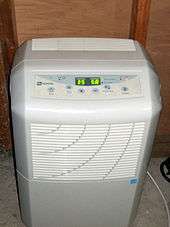
A specialized air conditioner that is used only for dehumidifying is called a dehumidifier. It also uses a refrigeration cycle, but differs from a standard air conditioner in that both the evaporator and the condenser are placed in the same air path. A standard air conditioner transfers heat energy out of the room because its condenser coil releases heat outside. However, since all components of the dehumidifier are in the same room, no heat energy is removed. Instead, the electric power consumed by the dehumidifier remains in the room as heat, so the room is actually heated, just as by an electric heater that draws the same amount of power.
In addition, if water is condensed in the room, the amount of heat previously needed to evaporate that water also is re-released in the room (the latent heat of vaporization). The dehumidification process is the inverse of adding water to the room with an evaporative cooler, and instead releases heat. Therefore, an in-room dehumidifier always will warm the room and reduce the relative humidity indirectly, as well as reducing the humidity directly by condensing and removing water.
Inside the unit, the air passes over the evaporator coil first, and is cooled and dehumidified. The now dehumidified, cold air then passes over the condenser coil where it is warmed up again. Then the air is released back into the room. The unit produces warm, dehumidified air and can usually be placed freely in the environment (room) that is to be conditioned.
Dehumidifiers are commonly used in cold, damp climates to prevent mold growth indoors, especially in basements. They are also used to protect sensitive equipment from the adverse effects of excessive humidity in tropical countries.
Energy transfer
In a thermodynamically closed system, any power dissipated into the system that is being maintained at a set temperature (which is a standard mode of operation for modern air conditioners) requires that the rate of energy removal by the air conditioner increase. This increase has the effect that, for each unit of energy input into the system (say to power a light bulb in the closed system), the air conditioner removes that energy.[40] To do so, the air conditioner must increase its power consumption by the inverse of its "efficiency" (coefficient of performance) times the amount of power dissipated into the system. As an example, assume that inside the closed system a 100 W heating element is activated, and the air conditioner has a coefficient of performance of 200%. The air conditioner's power consumption will increase by 50 W to compensate for this, thus making the 100 W heating element cost a total of 150 W of power.
It is typical for air conditioners to operate at "efficiencies" of significantly greater than 100%.[41] However, it may be noted that the input electrical energy is of higher thermodynamic quality (lower entropy) than the output thermal energy (heat energy).
Air conditioner equipment power in the U.S. is often described in terms of "tons of refrigeration", with each approximately equal to the cooling power of one short ton (2000 pounds or 907 kilograms) of ice melting in a 24-hour period. The value is defined as 12,000 BTU per hour, or 3517 watts.[42] Residential central air systems are usually from 1 to 5 tons (3.5 to 18 kW) in capacity.
Seasonal energy efficiency ratio
For residential homes, some countries set minimum requirements for energy efficiency. In the United States, the efficiency of air conditioners is often (but not always) rated by the seasonal energy efficiency ratio (SEER). The higher the SEER rating, the more energy efficient is the air conditioner. The SEER rating is the BTU of cooling output during its normal annual usage divided by the total electric energy input in watt hours (W·h) during the same period.[43]
- SEER = BTU ÷ (W·h)
this can also be rewritten as:
- SEER = (BTU / h) ÷ W, where "W" is the average electrical power in Watts, and (BTU/h) is the rated cooling power.
For example, a 5000 BTU/h air-conditioning unit, with a SEER of 10, would consume 5000/10 = 500 Watts of power on average.
The electrical energy consumed per year can be calculated as the average power multiplied by the annual operating time:
- 500 W × 1000 h = 500,000 W·h = 500 kWh
Assuming 1000 hours of operation during a typical cooling season (i.e., 8 hours per day for 125 days per year).
Another method that yields the same result, is to calculate the total annual cooling output:
- 5000 BTU/h × 1000 h = 5,000,000 BTU
Then, for a SEER of 10, the annual electrical energy usage would be:
- 5,000,000 BTU ÷ 10 = 500,000 W·h = 500 kWh
SEER is related to the coefficient of performance (COP) commonly used in thermodynamics and also to the Energy Efficiency Ratio (EER). The EER is the efficiency rating for the equipment at a particular pair of external and internal temperatures, while SEER is calculated over a whole range of external temperatures (i.e., the temperature distribution for the geographical location of the SEER test). SEER is unusual in that it is composed of an Imperial unit divided by an SI unit. The COP is a ratio with the same metric units of energy (joules) in both the numerator and denominator. They cancel out, leaving a dimensionless quantity. Formulas for the approximate conversion between SEER and EER or COP are available.[44]
- (1) SEER = EER ÷ 0.9
- (2) SEER = COP × 3.792
- (3) EER = COP × 3.413
From equation (2) above, a SEER of 13 is equivalent to a COP of 3.43, which means that 3.43 units of heat energy are pumped per unit of work energy.
The United States now requires that residential systems manufactured in 2006 have a minimum SEER rating of 13 (although window-box systems are exempt from this law, so their SEER is still around 10).
Installation types
Window unit and packaged terminal
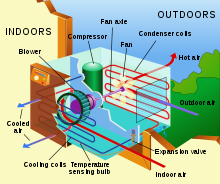
Window unit air conditioners are installed in an open window. The interior air is cooled as a fan blows it over the evaporator. On the exterior the heat drawn from the interior is dissipated into the environment as a second fan blows outside air over the condenser. A large house or building may have several such units, allowing each room to be cooled separately.
In 1971, General Electric introduced a popular portable in-window air conditioner designed for convenience and portability.[45]
Packaged terminal air conditioner (PTAC) systems are also known as wall-split air conditioning systems.[46] They are ductless systems. PTACs, which are frequently used in hotels, have two separate units (terminal packages), the evaporative unit on the interior and the condensing unit on the exterior, with an opening passing through the wall and connecting them. This minimizes the interior system footprint and allows each room to be adjusted independently. PTAC systems may be adapted to provide heating in cold weather, either directly by using an electric strip, gas, or other heater, or by reversing the refrigerant flow to heat the interior and draw heat from the exterior air, converting the air conditioner into a heat pump. While room air conditioning provides maximum flexibility, when used to cool many rooms at a time it is generally more expensive than central air conditioning.
The first practical semi-portable air conditioning unit was invented by engineers at Chrysler Motors and offered for sale starting in 1935.[47]
Split systems
Split-system air conditioners come in two forms: mini-split and central systems. In both types, the inside-environment (evaporative) heat exchanger is separated by some distance from the outside-environment (condensing unit) heat exchanger.
Split central (ducted) system
Common in U.S. homes and businesses, both in the U.S. and abroad. In these, an air handler that may contain a fan coil unit, a mechanism to heat the air and filter is placed inside a house or building and is connected to a condensing unit, which is outdoors. The air handler is controlled by a thermostat placed some distance away from the air handler. A user sets a desired temperature on the thermostat and the thermostat controls the air handler to maintain the set temperature. The air is fed through the air handler and, using ducts, into the spaces to be air conditioned. The air handler is usually placed away from the spaces that are air conditioned, in a different room. The air handler may get its air from outside or from the room, either through vents placed in doors or from ducts. The air handler may also be placed outside, contain a condenser and allowed to draw outside air. When these criteria are met, they are instead known as rooftop systems, rooftop units, rooftop packaged unit or packaged rooftop system. [48]
Mini-split (ductless) system
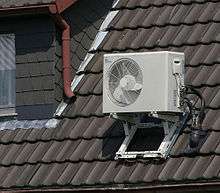

A mini-split system typically supplies air conditioned and heated air to a single or a few rooms of a building.[49] The name mini-split is often used to refer to those mini-split systems that only supply air to a single room. Multi-zone systems are a common application of ductless systems and allow up to 8 rooms (zones) to be conditioned from a single outdoor unit. Multi-zone systems typically offer a variety of indoor unit styles including wall-mounted, ceiling-mounted, ceiling recessed, and horizontal ducted. Mini-split systems typically produce 9,000 to 36,000 Btu (9,500–38,000 kJ) per hour of cooling to a single room or indoor unit. The first mini-split systems were sold in 1954-1968 by Mitsubishi Electric and Toshiba, in Japan. Its invention was motivated by the small size of modern Japanese homes, and the large size of traditional ducted central split systems. [50][51][52] Multi-zone (multi-split) systems provide extended cooling and heating capacity up to 60,000 Btu's to multiple rooms or indoor units simultaneously. Large multi-zone systems are known as VRF (Variable refrigerant flow) systems, and are often used in commercial buildings. Multi-zone ductless systems were invented by Daikin in 1973 and VRF systems were also invented by Daikin in 1982. Both were first sold in Japan.[53]
Advantages of the ductless system include smaller size and flexibility for zoning or heating and cooling individual rooms. The inside wall space required is significantly reduced. Also, the compressor and heat exchanger can be located farther away from the inside space, rather than merely on the other side of the same unit as in a PTAC or window air conditioner. Flexible exterior hoses lead from the outside unit to the interior one(s); these are often enclosed with metal to look like common drainpipes from the roof. In addition, ductless systems offer higher efficiency, reaching above 30 SEER.[54]
The primary disadvantage of ductless air conditioners is their cost. Such systems cost about US$1,500 to US$2,000 per ton (12,000 BTU per hour) of cooling capacity. This is about 30% more than central systems (not including ductwork) and may cost more than twice as much as window units of similar capacity."[55]
An additional possible disadvantage is that the cost of installing mini splits can be higher than some systems. However, lower operating costs and rebates or other financial incentives—offered in some areas—can help offset the initial expense.[56]
Multi-split system
A multi-split system[57] is a conventional split system, which is divided into two parts (evaporator and condenser) and allows cooling or heating of several rooms with one external unit. In the outdoor unit of this air conditioner there is a more powerful compressor, ports for connecting several traces and automation with locking valves for regulating the volume of refrigerant supplied to the indoor units located in the room.
A large Multi Split System is called a Variable refrigerant flow system and can be used instead of a central air conditioner system, as it allows for higher energy efficiency but it is more expensive to purchase and install.
Difference between split system and multi-split system:
Other common types of air conditioning system are multi-split systems, the difference between separate split system and multi-split system in several indoor units. All of them are connected to the main external unit, but the principle of their operation is similar to a simple split-system.
Its unique feature is the presence of one main external unit that connected to several indoor units. Such systems might be the right solution for maintaining the microclimate in several offices, shops, large living spaces. Just few of outdoor units do not worsen the aesthetic appearance of the building. The main external unit can be connected to several different indoor types: floor, ceiling, cassette, etc.
Multi-split system installation considerations
Before selecting the installation location of air conditioner, several main factors need to be considered. First of all, the direction of air flow from the indoor units should not fall on the place of rest or work area. Secondly, there should not be any obstacles on the way of the airflow that might prevent it from covering the space of the premises as much as possible. The outdoor unit must also be located in an open space, otherwise the heat from the house will not be effectively discharged outside and the productivity of the entire system will drop sharply. It is highly advisable to install the air conditioner units in easily accessible places, for further maintenance during operation.
The main problem when installing a multi-split system is the laying of long refrigerant lines for connecting the external unit to the internal ones. While installing a separate split system, workers try to locate both units opposite to each other, where the length of the line is minimal. Installing a multi-split system creates more difficulties, since some of indoor units can be located far from the outside. The first models of multi-split systems had one common control system that did not allow you to set the air conditioning individually for each room. However, now the market has a wide selection of multi-split systems, in which the functional characteristics of indoor units operate separately from each other.
The selection of indoor units has one restriction: their total power should not exceed the capacity of the outdoor unit. In practice, however, it is very common to see a multi-split system with a total capacity of indoor units greater than the outdoor capacity by at least 20%. However, it is wrong to expect better performance when all indoor units are turned on at the same time, since the total capacity of the whole system is limited by the capacity of the outdoor unit. Simply put, the outdoor unit will distribute all its power to all operating indoor units in such a way that some of the rooms may not have a very comfortable temperature level. However, the calculation of the total power is not simple, since it takes into account not only the nominal power of the units, but also the cooling capacity, heating, dehumidification, humidification, venting, etc.
Air-only central air conditioning
Central ducted A/C provides temperature control and ventilation to an area by conditioning air within an air handler and distributing it to one or more zones. The temperature of individual zones can be controlled by varying the airflow to each zone and/or reheating the air.
Central plant cooling
Central cooling plants are used to condition large commercial, industrial, or campus loads. At larger scales, the ductwork required to move conditioned air to and from the plant would be impractically large, so an intermediate fluid such as chilled water is used instead. The plant circulates cold water to terminal chilled water devices such as air handlers or fan/coil units. The plant often consists of a chiller, which may be water or air cooled. If water cooled, the chiller is cooled by a cooling tower.
Portable units
A portable air conditioner can be easily transported inside a home or office. They are currently available with capacities of about 5,000–60,000 BTU/h (1,500–18,000 W) and with or without electric-resistance heaters. Portable air conditioners are either evaporative or refrigerative.
The compressor-based refrigerant systems are air-cooled, meaning they use air to exchange heat, in the same way as a car radiator or typical household air conditioner does. Such a system dehumidifies the air as it cools it. It collects water condensed from the cooled air and produces hot air which must be vented outside the cooled area; doing so transfers heat from the air in the cooled area to the outside air.
Portable split system
A portable system has an indoor unit on wheels connected to an outdoor unit via flexible pipes, similar to a permanently fixed installed unit. The portable units draw indoor air and expel it outdoors through a single duct. Many portable air conditioners come with heat as well as dehumidification function.[58]
Portable hose system
Hose systems, which can be monoblock or air-to-air, are vented to the outside via air ducts. The monoblock type collects the water in a bucket or tray and stops when full. The air-to-air type re-evaporates the water and discharges it through the ducted hose and can run continuously.
A single-hose unit uses air from within the room to cool its condenser and then vents it outside. This air is replaced by hot air from outside or other rooms (due to the negative pressure inside the room), thus reducing the unit's overall efficiency.[59]
Modern units might have a coefficient of performance of approximately 3 (i.e., 1 kW of electricity will produce 3 kW of cooling). A dual-hose unit draws air to cool its condenser from outside instead of from inside the room, and thus is more effective than most single-hose units. These units create no negative pressure in the room.
Portable evaporative system
Evaporative coolers, sometimes called "swamp coolers", do not have a compressor or condenser. Liquid water is evaporated on the cooling fins, releasing the vapor into the cooled area. Evaporating water absorbs a significant amount of heat, the latent heat of vaporisation, cooling the air. Humans and animals use the same mechanism to cool themselves by sweating.
Evaporative coolers have the advantage of needing no hoses to vent heat outside the cooled area, making them truly portable. They are also very cheap to install and use less energy than refrigerative air conditioners.
Uses
Air-conditioning engineers broadly divide air conditioning applications into comfort and process applications.
Comfort applications
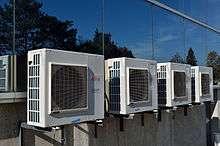
Comfort applications aim to provide a building indoor environment that remains relatively constant despite changes in external weather conditions or in internal heat loads.
Air conditioning makes deep plan buildings feasible, for otherwise they would have to be built narrower or with light wells so that inner spaces received sufficient outdoor air via natural ventilation. Air conditioning also allows buildings to be taller, since wind speed increases significantly with altitude making natural ventilation impractical for very tall buildings. Comfort applications are quite different for various building types and may be categorized as:
- Commercial buildings, which are built for commerce, including offices, malls, shopping centers, restaurants, etc.
- High-rise residential buildings, such as tall dormitories and apartment blocks
- Industrial spaces where thermal comfort of workers is desired
- Cars, aircraft, boats, which transport passenger or fresh goods
- Institutional buildings, which includes government buildings, hospitals, schools, etc.
- Low-rise residential buildings, including single-family houses, duplexes, and small apartment buildings
- Sports stadiums, such as State Farm Stadium in Arizona[60] and in Qatar for the 2022 FIFA World Cup[61]
Women have, on average, a significantly lower resting metabolic rate than men.[62] Using inaccurate metabolic rate guidelines for air conditioning sizing can result in oversized and less efficient equipment,[62] and setting system operating setpoints too cold can result in reduced worker productivity.[63] Dubai makes extensive use of air conditioning. [64][65][66]
In addition to buildings, air conditioning can be used for many types of transportation, including automobiles, buses and other land vehicles, trains, ships, aircraft, and spacecraft. High temperatures in metro system stations may be caused by train air conditioning. [67]
Domestic usage
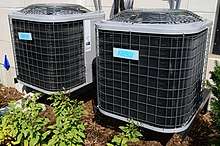
Air conditioning is common in the US, with 90% of new single-family homes constructed in 2019 including air conditioning, ranging from 99% in the South to 62% in the West. [68] [69] This has been the case since the 1960s. [70] In 2015, 90% of U.S. households had air conditioning.[71][72] The U.S consumes more energy for air conditioning than the rest of the world. [67] In Canada, air conditioning use varies by province. In 2013, 55% of Canadian households reported having an air conditioner, with high use in Manitoba (80%), Ontario (78%), Saskatchewan (67%), and Quebec (54%) and lower use in Prince Edward Island (23%), British Columbia (21%), and Newfoundland and Labrador (9%).[73] In Europe, home air conditioning is generally less common. Southern European countries such as Greece have seen a wide proliferation of home air-conditioning units in recent years.[74] In another southern European country, Malta, it is estimated that around 55% of households have an air conditioner installed.[75]
In China, the proportion of urban households with air conditioners increased from 8% to 70% in 9 years, from 1995 to 2004.[67] In 2016, it was predicted that by 2031, there would be an additional 700 million air conditioners worldwide. [76][77]
Process applications
Process applications aim to provide a suitable environment for a process being carried out, regardless of internal heat and humidity loads and external weather conditions. It is the needs of the process that determine conditions, not human preference. Process applications include these:
- Chemical and biological laboratories
- Cleanrooms for the production of integrated circuits, pharmaceuticals, and the like, in which very high levels of air cleanliness and control of temperature and humidity are required for the success of the process.
- Environmental control of data centers
- Facilities for breeding laboratory animals. Since many animals normally reproduce only in spring, holding them in rooms in which conditions mirror those of spring all year can cause them to reproduce year-round.
- Food cooking and processing areas
- Hospital operating theatres, in which air is filtered to high levels to reduce infection risk and the humidity controlled to limit patient dehydration. Although temperatures are often in the comfort range, some specialist procedures, such as open heart surgery, require low temperatures (about 18 °C, 64 °F) and others, such as neonatal, relatively high temperatures (about 28 °C, 82 °F).
- Industrial environments
- Mining
- Nuclear power facilities
- Physical testing facilities
- Plants and farm growing areas
- Textile manufacturing
- Microclimate control, as in humidors and collections care of cultural heritage
In both comfort and process applications, the objective may be to not only control temperature, but also humidity, air quality, and air movement from space to space.
Health effects
In hot weather, air conditioning can prevent heat stroke, dehydration from excessive sweating and other problems related to hyperthermia. Heat waves are the most lethal type of weather phenomenon in developed countries. Air conditioning (including filtration, humidification, cooling and disinfection) can be used to provide a clean, safe, hypoallergenic atmosphere in hospital operating rooms and other environments where proper atmosphere is critical to patient safety and well-being. It is sometimes recommended for home use by people with allergies.
Poorly maintained water cooling towers can promote the growth and spread of microorganisms such as Legionella pneumophila, the infectious agent responsible for Legionnaires' disease. As long as the cooling tower is kept clean (usually by means of a chlorine treatment), these health hazards can be avoided or reduced. The state of New York has codified requirements for registration, maintenance, and testing of cooling towers to protect against Legionella.[78]
Environmental impacts
Power consumption and efficiency
Production of the electricity used to operate air conditioners has an environmental impact, including the release of greenhouse gases. According to a 2015 government survey, 87% of the homes in the United States use air conditioning and 65% of those homes have central air conditioning. Most of the homes with central air conditioning have programmable thermostats, but approximately two-thirds of the homes with central air do not use this feature to make their homes more energy efficient.[79]
Lower-energy alternatives
Alternatives to continual air conditioning can be used with less energy, lower cost, and with less environmental impact. These include:[80]
- In large commercial buildings, making windows able to be opened by occupants when the air outside is cool enough to be comfortable
- Setting thermostats to around 82 °F (28 °C) and allowing workers to wear more climate-appropriate clothing, such as polo shirts and Bermuda shorts. This approach has worked for the Cool Biz campaign in Japan.
- Passive cooling techniques, such as:
- Passive solar cooling
- Natural ventilation under and through buildings
- Operating windows to induce a stack effect breeze
- Letting in cool air at night and closing windows during the day.:[81]
- Operating shades to reduce solar gain
- Building slightly underground, to take advantage of unpowered conduction and geothermal mass
- Placement of trees, architectural shades, windows (and using window coatings) to reduce solar gain
- Thermal insulation placed to prevent heat from entering
- Light-colored building materials reflect away more incoming infrared radiation
- Using a fan if the air is below body temperature
- Using naturally cooler basement rooms more
- Taking a siesta during the hottest part of the day
- Sleeping outside on a porch or roof
- Deep water source cooling
Automobile power consumption
In an automobile, the A/C system will use around 4 horsepower (3 kW) of the engine's power, thus increasing fuel consumption of the vehicle.[82]
Refrigerants
The selection of the working fluids (refrigerants) has a significant impact not only on the performance of the air conditioners but on the environment as well. Most refrigerants used for air conditioning contribute to global warming, and many also deplete the ozone layer.[83] CFCs, HCFCs, and HFCs are potent greenhouse gases when leaked to the atmosphere.
The use of CFC as a refrigerant was once common, including the refrigerants R-11 and R-12 (sold under the brand name Freon-12). Freon refrigerants were commonly used during the 20th century in air conditioners due to their superior stability and safety properties. When they are released accidentally or deliberately, these chlorine-bearing refrigerants eventually reach the upper atmosphere.[84] Once the refrigerant reaches the stratosphere, UV radiation from the Sun homolytically cleaves the chlorine-carbon bond, yielding a chlorine radical. These chlorine radicals catalyze the breakdown of ozone into diatomic oxygen, depleting the ozone layer that shields the Earth's surface from strong UV radiation. Each chlorine radical remains active as a catalyst until it binds with another radical, forming a stable molecule and quenching the chain reaction.
Prior to 1994, most automotive air conditioning systems used R-12 as a refrigerant. It was replaced with R-134a refrigerant, which has no ozone depletion potential. Old R-12 systems can be retrofitted to R-134a by a complete flush and filter/dryer replacement to remove the mineral oil, which is not compatible with R-134a.
R22 (also known as HCFC-22) has a global warming potential about 1,800 times higher than CO2.[85] It was phased out for use in new equipment by 2010, and is to be completely discontinued by 2020. Although these gasses can be recycled when air conditioning units are disposed of, uncontrolled dumping and leaking can release gas directly into the atmosphere.
In the UK, the Ozone Regulations[86] came into force in 2000 and banned the use of ozone depleting HCFC refrigerants such as R22 in new systems. The Regulation banned the use of R22 as a "top-up" fluid for maintenance between 2010 (for virgin fluid) and 2015 (for recycled fluid). This means that equipment that uses R22 can still operate, as long as it does not leak. Although R22 is now banned, units that use the refrigerant can still be serviced and maintained.
The manufacture and use of CFCs has been banned or severely restricted due to concerns about ozone depletion (see also Montreal Protocol).[87][88] In light of these environmental concerns, beginning on November 14, 1994, the U.S. Environmental Protection Agency has restricted the sale, possession and use of refrigerant to only licensed technicians, per rules under sections 608 and 609 of the Clean Air Act.[89]
As an alternative to conventional refrigerants, other gases, such as CO2 (R-744), have been proposed.[90] R-744 is being adopted as a refrigerant in Europe and Japan. It is an effective refrigerant with a global warming potential of 1, but it must use higher compression to produce an equivalent cooling effect.
In 1992, a non-governmental organization, Greenpeace, was spurred by corporate executive policies and requested that a European lab find substitute refrigerants. This led to two alternatives, one a blend of propane (R290) and isobutane (R600a), and one of pure isobutane.[27][31] Industry resisted change in Europe until 1993, and in the U.S. until 2011, despite some supportive steps in 2004 and 2008 (see Refrigerant Development above).[36][91]
In 2019 the UNEP published new voluntary guidelines,[92] however as of 2020 many countries have not yet ratified the Kigali Accord.
Economic effects
Demographical
Air conditioning caused various shifts in demography, notably that of the U.S starting from the 1970s.
First, the number of births became much less varied throughout the year. Whereas, until 1970, the birth rate in the spring was lower than during the other seasons, the introduction of air conditioning leveled out this difference at the end of the 20th century.[93]
Mortality rate was also affected, especially during the summer and in regions subject to heatwave; up to a 2% decrease from the 30s to the 90s.
More surprising is the gradual movement of populations from northern states to southern states within those same 60 years. The Sun Belt now welcomes 30% of the total US population when it was inhabited by only 24% of Americans at the beginning of the last century. Outside the US, Dubai and Singapore also reflect the magical effects of Carrier's invention.[94]
Effects in production
First designed to benefit targeted industries such as the press as well as large factories, the invention quickly spread to public agencies and administrations. As a matter of fact, studies published by Carrier's at the time showed an increase of productivity close to 24% in places equipped with air conditioning.[95]
Cost of production
The energy use for cooling in the U.S have spurted in the last 30 years from 50 to 2000 TW per hour (1 TW= 10^12 Watt). This gigantic amount represents the consumption of the whole African continent alone. According to the International Energy Agency, cooling is expected to represent up to 37% of the world's total energy use in 2050.[96]
See also
- Air conditioner inverter
- Cassette air conditioner
- Crankcase heater
- Energy label
- Ground-coupled heat exchanger
- Hydronics
- Ice storage air conditioning
- List of home appliances
- Louver
- Seawater air conditioning
- Trombe wall
- Thermoacoustic refrigerator
- Uniform Mechanical Code
- Working fluids
References
- "air con Definition in the Cambridge English Dictionary". dictionary.cambridge.org. Retrieved 1 March 2018.
- Darling, David. "Earth cooling tube". daviddarling.info. Retrieved 1 March 2018.
- McDowall, Robert (2006). Fundamentals of HVAC Systems. Elsevier. p. 3. ISBN 9780080552330.
- "Air conditioning use emerges as one of the key drivers of global electricity-demand growth - News". IEA. Retrieved 2020-08-02.
- "Keeping cool in the face of climate change". UN News. 2019-06-30. Retrieved 2020-03-30.
- Campbell, Iain; Kalanki, Ankit; Sachar, Sneha (2018). Solving the Global Cooling Challenge: How to Counter the Climate Threat from Room Air Conditioners (PDF) (Report).
- Nagengast, Bernard (February 1999). "A History of Comfort Cooling Using Ice" (PDF). ASHRAE Journal: 49. Archived from the original (PDF) on 12 August 2013.
- Bahadori, M.N. (February 1978). "Passive Cooling Systems in Iranian Architecture". Scientific American. 238 (2): 144–154. Bibcode:1978SciAm.238b.144B. doi:10.1038/scientificamerican0278-144.
- Needham, Joseph (1991). Science and Civilisation in China, Volume 4: Physics and Physical Technology, Part 2, Mechanical Engineering. Cambridge University Press. pp. 99, 151, 233. ISBN 978-0-521-05803-2.
- Needham, Joseph (1991). Science and Civilisation in China, Volume 4: Physics and Physical Technology, Part 2, Mechanical Engineering. Cambridge University Press. pp. 134, 151. ISBN 978-0-521-05803-2.
- Laszlo, Pierre (2001). Salt: Grain of Life. Comumbia University Press. p. 117. ISBN 9780231121989.
Cornelius Drebbel air conditioning.
- Franklin, Benjamin (17 June 1758). "Letter to John Lining". Retrieved 6 August 2014.
- Palermo, Elizabeth (1 May 2014). "Who Invented Air Conditioning?". Live Science. Future US. Retrieved 26 August 2019.
- Varrasi, John (6 June 2011). "Global Cooling: The History of Air Conditioning". The American Society of Mechanical Engineers. Retrieved 26 August 2019.
- Simha, R.V. (February 2012). "Willis H Carrier". Resonance: Journal of Science Education. Springer Science+Business Media. 17 (2): 117–138. doi:10.1007/s12045-012-0014-y. ISSN 0973-712X.
- Gulledge III, Charles; Knight, Dennis (11 February 2016). "Heating, Ventilating, Air-Conditioning, And Refrigerating Engineering". Whole Building Design Guide. National Institute of Building Sciences. Retrieved 26 August 2019.
Though he did not actually invent air-conditioning nor did he take the first documented scientific approach to applying it, Willis Carrier is credited with integrating the scientific method, engineering, and business of this developing technology and creating the industry we know today as air-conditioning.
- "Willis Carrier - 1876-1902". www.williscarrier.com.
- Apparatus for treating air, 16 September 1904, retrieved 31 October 2018
- Green, Amanda (January 1, 2015). "A Brief History of Air Conditioning". Popular Mechanics. Retrieved 31 January 2020.
- "Early University Benefactors" (PDF). Rizzoconferencecenter.com. Retrieved 8 November 2012.
- "Unsung Engineering Heros: Robert Sherman". Navlog.org. Retrieved 10 June 2015.
- "History of Air Conditioning". Energy.gov. Retrieved 2020-04-28.
- "Air Conditioners & Dehumidifiers". Sylvane. July 2011.
- Mate, John "Making a Difference: A Case Study of the Greenpeace Ozone Campaign" RECIEL 10:2 2001.
- Benedick, Richard Elliot Ozone Diplomacy Cambridge, MA: Harvard University 1991.
- "Happy birthday, Greenfreeze!". Greenpeace. Retrieved 8 June 2015.
- "Ozone Secretariat". United Nations Environment Programme. Archived from the original on 12 April 2015.
- Gunkel, Christoph (13 September 2013). "Öko-Coup aus Ostdeutschland". Der Spiegel (in German). Retrieved 4 September 2015.
- "La Historia del "Greenfreeze"". Ilustrados.com. Retrieved 10 June 2015.
- "Discurso de Frank Guggenheim no lançamento do Greenfreeze | Brasil". Greenpeace.org. Retrieved 10 June 2015.
- "Greenfreeze: a Revolution in Domestic Refrigeration". www.ecomall.com. Retrieved 8 June 2015.
- "Der Greenfreeze - endlich in den USA angekommen" (in German). Greenpeace.de. 28 December 2011. Retrieved 10 June 2015.
- "PepsiCo Brings First Climate-Friendly Vending Machines to the U.S." phx.corporate-ir.net. Retrieved 8 June 2015.
- "Climate-Friendly Greenfreezers Come to the United States". WNBC. Retrieved 8 June 2015.
- "GreenFreeze". Greenpeace.
- "Significant New Alternatives Program: Substitutes in Household Refrigerators and Freezers". Epa.gov. 13 November 2014. Retrieved 4 June 2018.
- Smith, Shane (2000). Greenhouse gardener's companion: growing food and flowers in your greenhouse or sunspace (2nd ed.). Fulcrum Publishing. p. 62. ISBN 978-1-55591-450-9.
- Snijders, Aart (2008). "ATES Technology Development and Major Applications in Europe" (PDF). Conservation for the Living Community Workshop (Toronto and Region Conservation Authority. IFTech International. Retrieved 1 March 2018.
- "Dristeem: Humidity and Comfort" (PDF). Retrieved 25 March 2019.
- Kreider, Jan F., ed. (2001). Handbook of heating, ventilation, and air conditioning. CRC Press. ISBN 978-0-8493-9584-0.
- Winnick, J. (1996). Chemical engineering thermodynamics. John Wiley and Sons. ISBN 978-0-471-05590-7.
- "NIST Guide to the SI". National Institute of Standards and Technology. Archived from the original on 28 May 2007. Retrieved 18 May 2007.
- "Energy Glossary – S". Energy Glossary. Energy Information Administration. Retrieved 2 July 2006.
- "SEER conversion formulas from Pacific Gas and Electric" (PDF). Archived from the original (PDF) on 2 December 2007. Retrieved 9 July 2020.
- "Timeline: Bright ideas". The Boston Globe. 13 January 2016. Retrieved 17 April 2017.
- "PTAC Buying Guide". Sylvane.
- "Room-size air conditioner fits under window sill". Popular Mechanics. Vol. 63 no. 6. June 1935. p. 885. Retrieved January 31, 2020.
- "Central Air Conditioning". Energy.gov.
- "Mitsubishi Contractors Guide" (PDF). Mitsubishipro.com. p. 16. Archived from the original (PDF) on 26 February 2015.
- "Air-conditioning Systems - Overview - Milestones". www.mitsubishielectric.com.
- "Toshiba Carrier Global | Air conditioner | About Us | History". www.toshiba-carrier.co.jp.
- Corporation, Mitsubishi Electric. "1920s-1970s | History | About". Mitsubishi Electric Global Website.
- "History of Daikin Innovation". daikin.com. Retrieved January 31, 2020.
- "Mitsubishi Electric US, Cooling & Heating | HVAC". Mitsubishipro.com. 17 February 2010. Archived from the original on 3 June 2015.
- "Ductless Mini-Split Air Conditioners". US Department of Energy. 9 August 2012. Retrieved 14 June 2013.
- "Ductless, mini-Split Heat Pumps". US Department of Energy. Retrieved 19 June 2013.
- Trott, A.R.; Welch, T. (2000). Refrigeration and Air-Conditioning. Great Britain: Reed Educational and Professional Publishing Ltd. p. 312. ISBN 0-7506-4219-X.
- "Portable Vs Split System Air Conditioning | Pros & Cons". Canstar Blue. August 14, 2018.
- "In the two hose design the exchanged air does not come from the interior of the room or house, but enters through the second hose". Experts123.com. Retrieved 10 June 2015.
- "Qatar promises air-conditioned World Cup". CNN. 3 December 2010.
- "BBC World Service - News - Qatar 2022: How to build comfortable stadiums in a hot climate". Bbc.co.uk. 3 December 2010. Retrieved 8 November 2012.
- Kingma, Boris; van Marken Lichtenbelt, Wouter (3 August 2015). "Energy consumption in buildings and female thermal demand". Nature. 5 (12): 1054. Bibcode:2015NatCC...5.1054K. doi:10.1038/NCLIMATE2741.
- Lang, Susan (19 October 2004). "Study links warm offices to fewer typing errors and higher productivity". Cornell Chronicle. Retrieved 25 September 2015.
- "An inversion of nature: how air conditioning created the modern city | Cities | The Guardian". amp.theguardian.com.
- "How the Air Conditioner Made Modern America". The Atlantic.
- "48 new air-conditioned bus shelters in Dubai soon". Gulf News.
- Carroll, Rory (26 October 2015). "How America became addicted to air conditioning". The Guardian. Retrieved 9 July 2020.
- US Census Bureau (MCD): Cheryl Cornish, Stephen Cooper, Salima Jenkins. "Characteristics of New Housing". census.gov.CS1 maint: uses authors parameter (link)
- "Central Air Conditioning Buying Guide". Consumer Reports.
- "History of Air Conditioning". Energy.gov.
- Montgomery, David. "What You Might Not Know About Air Conditioning". CityLab.
- https://www.washingtonpost.com/news/worldviews/wp/2015/07/22/europe-to-america-your-love-of-air-conditioning-is-stupid/?outputType=amp
- "Statistics Canada - Households and the Environment Survey, 2013". The Daily - Households and the Environment Survey, 2013. Statistics Canada. 10 March 2015. Retrieved 11 May 2015.
- "Χρυσές" δουλειές για τις εταιρείες κλιματιστικών έφερε το κύμα καύσωνα (in Greek). Lambrakis Press. 25 July 2007. Retrieved 30 June 2008.
- "STĦARRIĠ DWAR ID-DĦUL U L-INFIQ TAL-FAMILJA 2008 /Household Budgetary Survey 2008" (PDF). National Statistics Office, Maltz. Retrieved 14 July 2011.
- "How air-conditioning made America — and how it could break us all". July 26, 2016.
- https://www.washingtonpost.com/news/energy-environment/wp/2016/05/31/the-world-is-about-to-install-700-million-air-conditioners-heres-what-that-means-for-the-climate/
- "Protection Against Legionella". health.ny.gov. Retrieved 25 March 2019.
- "One in eight U.S. homes uses a programmed thermostat with a central air conditioning unit". U.S. Energy Information Administration. U.S. Department of Energy. 19 July 2017. Retrieved 20 July 2017.
- Neyfakh, Leon (21 July 2013). "How to live without air conditioning". The Boston Globe.
- Jethva, Hardik (June 2020). "Quick Tips to Save Energy Consumption and Money". BestCheck.
- "Impact of Vehicle Air-Conditioning on Fuel Economy" (PDF). National Renewable Energy Laboratory. Retrieved 6 February 2012.
- "Refrigerant Management Program Refrigerants Regulated". Californial Environmental Protection Agency. Archived from the original on 4 October 2013.
- "Chemicals in the Environment: Freon 113 (CAS NO. 76-13-1) : prepared by Office of Pollution Prevention and Toxics" (TXT). Epa.gov. August 1994. Retrieved 10 June 2015.
- "Chapter.2_FINAL.indd" (PDF). Retrieved 9 August 2010.
- "2010 to 2015 government policy: environmental quality". GOV.UK. 8 May 2015. Retrieved 10 June 2015.
- "Destruction Of Ozone Layer Is Slowing After Worldwide Ban On CFC Release". ScienceDaily. July 30, 2003. Retrieved January 31, 2020.
- Schlossberg, Tatiana (9 August 2016). "How Bad Is Your Air-Conditioner for the Planet?". The New York Times. Retrieved 17 August 2016.
- "Complying With The Section 608 Refrigerant Recycling Rule | Ozone Layer Protection - Regulatory Programs | US EPA". Epa.gov. 21 April 2015. Retrieved 10 June 2015.
- "The current status in Air Conditioning – papers & presentations". R744.com. Archived from the original on 14 May 2008.
- "Greenfreeze F-Gas Victory! Greener Refrigerators Finally Legal in the U.S." Greenpeace.org. Archived from the original on 12 June 2015.
- Environment, U. N. (2019-10-31). "New guidelines for air conditioners and refrigerators set to tackle climate change". UN Environment. Retrieved 2020-03-30.
- Barreca, Alan; Clay, Karen; Deschênes, Olivier; Greenstone, Michael; Shapiro, Joseph S. (February 2016). "Adapting to climate change: the remarkable decline in the U.S. temperature-mortality relationship over the 20th century". Journal of Political Economy. 124 (1). doi:10.1086/684582.
- Glaeser, Edward; Tobio, Kristina (April 2007). "The Rise of the Sunbelt". Southern Economic Journal. 74 (3): 610–643. doi:10.3386/w13071. Retrieved January 31, 2020.
- Nordhaus, W.D. (2006-02-10). "Geography and macroeconomics: New data and new findings". Proceedings of the National Academy of Sciences. 103 (10): 3510–3517. doi:10.1073/pnas.0509842103. ISSN 0027-8424. PMID 16473945.
- "Cooling". iea.org. Retrieved 2019-09-10.
External links

- Air Handling Units CFD Simulation on YouTube
- U.S. Patent 808,897 Carrier's original patent
- U.S. Patent 1,172,429
- U.S. Patent 2,363,294
